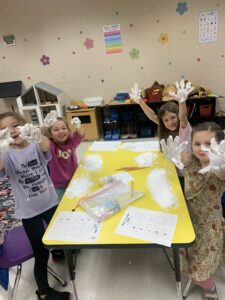
Welcome to First Grade!
In our class we become a community of learners. Students will learn to work together throughout the year. I place a strong emphasis on teamwork and collaboration, as cottage school provides a unique opportunity for homeschool students to develop important social skills and learn how to engage with their peers in a supportive, collaborative environment.
I believe in the power of hands-on and movement-based learning, where students are actively engaged and can physically interact with what they are learning. I provide the tools and accommodations needed for each student to approach every lesson with confidence. My mission is to support each student’s growth by helping them recognize their unique strengths and value. By creating a safe, inclusive environment where students can interact, share ideas, and learn together, I strive to foster a love of learning and give them the tools they need to grow both as individuals and as curious learners.
Each week in our class, we explore a new unit theme that sparks curiosity and excitement. In the past, we’ve explored themes like dinosaurs, weather, the human body, arctic animals, building, the solar system, and many more based on the interests of the students. Our daily schedule is designed around four “missions” or lessons that align with that week’s theme, along with structured play breaks. These missions cover a wide range of subjects, including science, reading, math, history, writing, process art, and STEM challenges.
A Sample Day in the First Grade Classroom
Our day begins with a calm and welcoming Arrival period. As students enter the classroom, they’ll find a simple activity waiting at their tables—this could be playdough, building blocks, a coloring sheet, or even an ongoing project from the previous week. These quiet, engaging tasks are completely optional and help ease students into the day as we wait for everyone to arrive. We then move into our Morning Meeting, where students gather to share highlights from their week, participate in calendar time, and talk about the day’s theme. This time sets the tone for a connected and thoughtful day of learning. Next, it’s time for Movement, which may take place in the gym or through a group game in the classroom. This active break helps students get their bodies moving and minds ready to focus.
The main part of our school day consists of 4 Missions, interspersed with periods of open-ended play, snack and lunch.
For example, on Zoo Day, students were presented the following Missions:
Mission 1 – students are introduced to a class-wide challenge: building a zoo! Working in pairs, they’ll head to the school library to research their chosen animals. With the help of nonfiction texts and images, students will learn about habitats and animal needs, guided by the teacher and supported by parent volunteers.
Mission 2 – students begin designing their habitat models. They’ll draw and outline details based on their research and brainstorm how to bring those ideas to life using creative building materials.
Mission 3 – students collaborate using a variety of STEM-inspired materials to construct model habitats for their animals. This is a hands-on, teamwork-driven part of the day that brings together science, creativity, and problem-solving.
Mission 4 – students present their completed animal habitats to the class. This presentation time encourages confidence, communication, and pride in their work.
Before the day ends, students participate in Classroom Jobs/Break Time, where they complete their assigned responsibilities or enjoy a quiet moment to read, chat with a friend, or relax. We close our day with a reflective Afternoon Meeting. The teacher poses an exit question, and students have the chance to share a compliment with a peer or talk about their favorite part of the day, ending things on a kind and thoughtful note.















